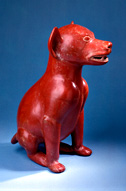|

Comment
on this story
What:
World Views and Images For Eternity
Where:
UT's McClung Museum, 1327 Circle Park Drive
When:
Through Jan. 4. Call 974-2144 for information.
|
|

Dual exhibits present a range of artifacts
by Heather Joyner Spica
Twenty-one years ago, William P. Palmer III of Falmouth Foreside, Maine, willed a collection of Mayan artifacts to the University of Maine's Hudson Museum. Mostly purchased from a Manhattan dealer in the late 1960s, Palmer's objects, alongside a fascinating array of West Mexican tomb figures (also from the Hudson Museum), are on loan to the McClung Museum for another month. Together, the above Mesoamerican artifacts—Mesoamerican being an area covering all or parts of present-day Mexico, Belize, Guatemala, Honduras, El Salvador, and Nicaragua—form joint exhibits titled World Views and Images For Eternity.
Shared ownership and general provenance notwithstanding, displayed items are only somewhat connected, providing an interesting mix. Although both collections feature figures like ceremonial ball players (possibly female in the west) and animals serving as human counterparts of sorts, the cosmology connected to West Mexican objects is presumably less complex than that of the mind-boggled Mayas. Furthermore, unlike Mayan figures, ornaments, vases, and bowls, the shaft tomb figures from Western Mexican states reflect the influence of South American traders like Peru's Paracas people. They also reveal clues to far less explored cultures long considered "marginal." But as rich and mighty as Mayan civilization was before the Spanish Conquest, it was not the only thing going in Mesoamerica.
Artifacts comprising Images For Eternity are drawn from the Western states of Nayarit, Jalisco, Colima, and Michoac�n and include 61 ceramic objects, two shell objects, two stone objects, and a plaster figurine (some of which were part of the Art Institute of Chicago's show titled Ancient West Mexico). Hudson Museum Director and Curator Stephen Whittington stated that Images For Eternity "...discusses progress being made by modern scholars in understanding West Mexican tomb figures that have lost their original context."
Perhaps that sounds dull, but again, such tombs represent a relatively new area of interest. For instance, it was a mere 10 years ago that archaeologist Jorge Ramos excavated an undisturbed burial site in Jalisco, discovering precious stone jewelry, vessels, weaponry, and fabric as well as figures. What's more, the figures —generally spanning a 500-year period beginning in 200 B.C.E.—are quite varied and sophisticated in terms of craftsmanship. Some examples of particularly refined pieces are animal figures and bottle-like vessels from Colima. Whether they are stylized or realistic-looking, dogs created in the Comala style of Colima have a mischievous, robust presence. Fitting the latter description is a cinnamon-colored seated dog with a beautifully modeled form. However, its eyes are crudely drawn ovals, as if to imply that the animal's soul has fled. A more convincing dog's head can be found on a "teardrop bottle." A "double-spout bottle with incised hummingbirds" has an equally unexpected and memorable shape. As for the ritual purposes of Colima objects and those from other regions, numerous questions remain. Having seen such exotic objects peppering ads for Kahl�a liquor and concealing microfilm in movies like Hitchcock's North By Northwest, it's easy to take their sacred status for granted. Yet as secular as they often appear to be, many figures are presumably spiritual in nature. All that's for certain, according to Peter T. Furst, Professor Emeritus of the University of Pennsylvania and author of Flesh of the Gods: The Ritual Use of Hallucinogens, ancient West Mexicans, like their Mayan counterparts, were heavy into mind-altering substances. "[They feature] shamans who intercede with spirits, transformations, and non-ordinary reality induced by drugs...many whistles were meant for use in the supernatural realm, as a living person cannot physically blow them," says Furst about the objects' religious references.
Otherworldly visions gleaned from hallucinatory experiences—combined with all that we still don't know in terms of facts—make the meaning of west Mexican tomb artifacts that much harder to decipher. But we need not know everything about them to find creations like the model of a teponaztle hollow log drum (Colima) or a Nayarit marriage pair interesting.
The Mayan worldview, referenced in the Palmer Collection exhibit's title, is not as new to us. Brilliant mathematical and astronomical advances of the Mayas' Classic period (roughly 250 — 900 A.D.) are well documented. The "look" of artifacts is familiar. Nevertheless, they remain dizzying in their symbolic scope. Less complicated is the Mayan cylinder vase form (there are 19 examples on display in addition to bowls), ornaments, and other figures.
The Mayan cylinder becomes a "given" format for different images—a form that does not interact with what was incised into or painted upon it. Apparently, that's a non-issue, as are "pseudoglyphs" substituting for famed Mayan hieroglyphs when artisans were only semi-literate or addressing a not-so-elite audience. Basically, it amounts to this: World Views presents loads of objects that look the same at first glance. They are, of course, quite different upon closer inspection, and they are jazzed up by gods, monsters, and heroes found in Xibalba (the Underworld), and by scenes depicting rulers and their attendants.
The combined McClung exhibits are visually unified by a wide band of gold and orange paint extending throughout the gallery space. Spanish subtitles are ironic in a sense, but seem to be a plus. Information comparing and contrasting the two regions' artifacts might make the pairing seem less a matter of coincidence and more of a learning experience. After all, we're looking at amazing remnants of complex worlds, with messages many people attempted to destroy; the Mayas' painted books or "codices," for example, were considered evil and burned by 15th century religious zealots. They can be seen in relative calm until the student holidays are over, and they are worth seeing.

December 4, 2003 * Vol. 13, No. 49
© 2003 Metro Pulse
|





